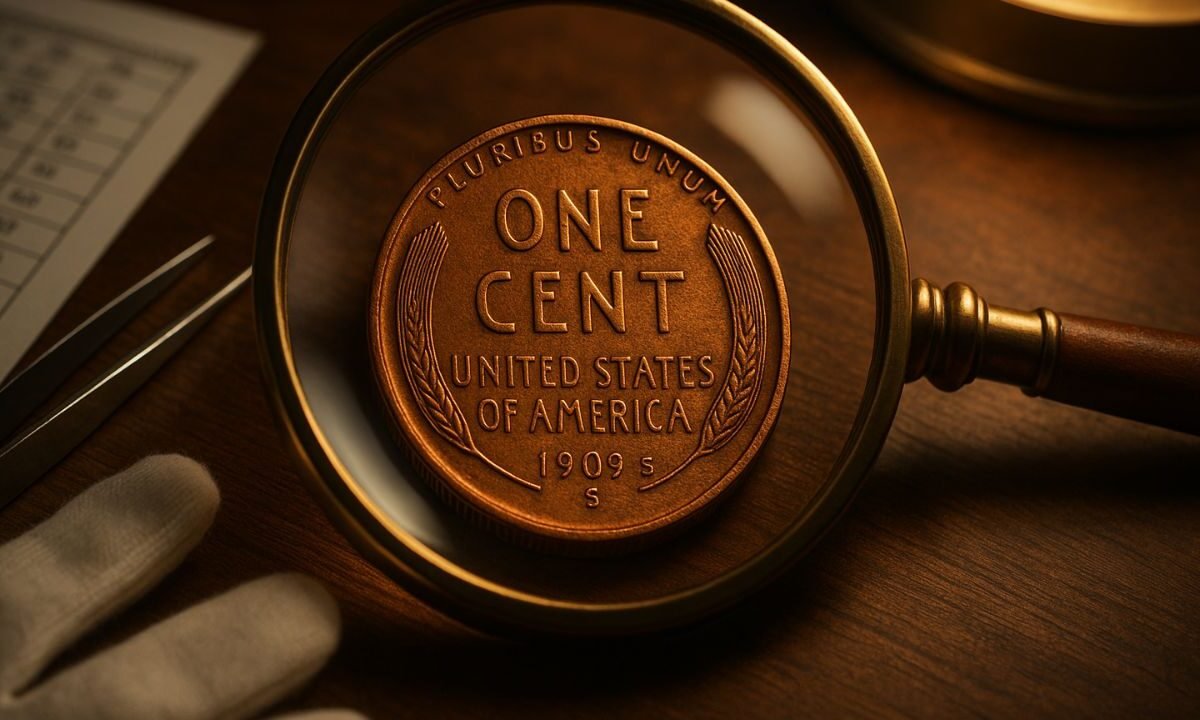The 1909-S VDB penny is the most talked-about Lincoln Wheat cent because it combines a short production run with a headline-making design change.
Designer Victor David Brenner’s initials (“VDB) appeared boldly at the bottom of the reverse when the new Lincoln cent debuted in 1909.
After public pushback, the Mint removed the initials just days later — leaving San Francisco’s run with only 484,000 coins.
That tiny mintage turned the 1909-S VDB into a key date that collectors have chased for more than a century.
Fast Facts & Specs
- Mint: San Francisco (“S”)
- Mintage: 484,000
- Composition: 95% copper, 5% tin & zinc
- Weight: 3.11 g; Diameter: 19.0 mm; Plain edge
- Designer: Victor David Brenner
These technical details are standard for bronze Wheat cents of 1909 and help you confirm a coin’s basics before digging deeper.
Current Market Highlights (2022–2025)
Top, fully red examples still command huge money. The auction record for a blazing MS67 RD is around $168,000 (April 2022).
More recently, a MS67 Red brought $99,000 in January 2025 — showing that six-figure prices are still possible for the very finest pieces.
Typical Value Ranges (Guidepost Snapshot)
Values swing with color designation (BN = Brown, RB = Red-Brown, RD = Red) and grade.
Circulated coins remain expensive because demand is so strong, while the biggest jumps appear in high Mint State with full red luster.
| Grade (guidepost) | Ballpark Value* | Notes |
|---|---|---|
| G-VG (Good–Very Good) | $700–$1,200 | Entry point for genuine, problem-free pieces |
| VF–XF (Very Fine–Extremely Fine) | $1,500–$3,500 | Sharper wheat lines and hair detail increase appeal |
| AU50–AU58 | $4,000–$7,500 | Nearly Uncirculated; great eye appeal without MS price |
| MS63–MS64 RB/RD | $8,000–$25,000 | Popular sweet spot for serious sets |
| MS65 RD | $35,000–$80,000+ | Condition rarity drives big jumps |
| MS67 RD (finest known tier) | Up to $168,000 | Record level for elite pieces |
*Indicative ranges compiled from recent auction realizations and major price-guide references; actual prices depend on color, strike, eye appeal, and certification.
How to Identify a Genuine 1909-S VDB
- Look for “VDB”: The initials sit at the bottom center of the reverse (between the wheat stalks).
- Check the mintmark: The “S” is under the date. There are four known mintmark positions used on genuine dies; fakes often have added or wrong-style mintmarks.
- Weight & metal: Authentic pieces are bronze and weigh about 3.11 g; a big deviation can signal trouble.
- Third-party grading: Because counterfeits are common, buying PCGS/NGC-certified coins reduces risk and protects resale value. Survival estimates also show how few high-grade coins exist (only a few thousand at MS65 or better).
A Short History You Can Use in Listings
The coin launched August 2, 1909, to huge fanfare — crowds lined up for the first U.S. coin with a real person (Abraham Lincoln).
After a press fuss over the initials, the Mint pulled the design within days, removed “VDB,” and resumed production.
That sudden change created the famous 1909-S VDB key date that anchors almost every serious Lincoln cent collection.
Collector Tips
- Prioritize originality: Un-cleaned surfaces and natural color matter.
- Color drives price: Red (RD) beats Red-Brown (RB), which beats Brown (BN) at the same numeric grade.
- Provenance helps: Traceable auction history and top-tier certification often increase buyer confidence and price. Recent sales near and above $100,000 show sustained demand for the finest examples.
The 1909-S VDB penny blends low mintage, a headline-making design change, and strong collector demand to stay valuable across all grades.
Whether you’re hunting a decent circulated example or dreaming of a blazing MS Red trophy, focus on authenticity, eye appeal, and certification.
With smart buying and careful verification, this small cent can become a cornerstone coin — and, at the top end, a true six-figure rarity.
FAQs
Where exactly are the “VDB” initials?
They’re at the bottom center of the reverse, between the wheat stalks. On the “Weak VDB” variety they appear much lighter or partially missing.
What’s the most expensive 1909-S VDB sold for recently?
A top MS67 Red brought around $99,000 in January 2025, while the standing record remains close to $168,000 for an MS67 RD.
How can I avoid buying a counterfeit?
Verify the mintmark position and style, check weight and diameter, and choose PCGS/NGC-certified pieces when possible. Study the four genuine “S” positions known for this date.

